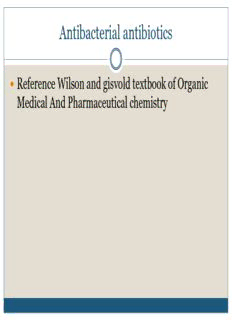
Antibacterial antibiotics PDF
Preview Antibacterial antibiotics
Antibacterial antibiotics Reference Wilson and gisvold textbook of Organic Medical And Pharmaceutical chemistry Antibiotics (literally “against life”) as the biological concept of survival of the fittest, in which one organism destroys another to preserve itself The word antibiotic was derived from this root. An antibiotic or antibiotic substance is a substance produced by microorganisms, which has the capacity of inhibiting the growth and even of destroying other microorganisms.” Later proposals have sought both to expand and to restrict the definition to include any substance produced by a living organism that is capable of inhibiting the growth or survival of one or more species of microorganisms in low concentrations The advances made by medicinal chemists to modify naturally occurring antibiotics and to prepare synthetic analogs necessitated the inclusion of semisynthetic and synthetic derivatives in the definition. Therefore, a substance is classified as an antibiotic if the following conditions are met: 1. It is a product of metabolism (although it may be duplicated or even have been anticipated by chemical synthesis). 2. It is a synthetic product produced as a structural analog of a naturally occurring antibiotic. 3. It antagonizes the growth or survival of one or more species of microorganisms. 4. It is effective in low concentrations. CHEMICAL CLASSIFICATION The chemistry of antibiotics is so varied that a chemical classification is of limited value Some similarities can be found, however, indicating that some antibiotics may be the products of similar mechanisms in different organisms and that these structurally similar products may exert their activities in a similar manner For example, several important antibiotics have in common a macrolide structure (i.e., a large lactone ring) e.g. erythromycin and oleandomycin The tetracycline family comprises a group of compounds very closely related chemically. Several compounds contain closely related amino sugar moieties, such as those found in streptomycins , kanamycins, neomycins, paromomycins, and gentamicins. The bacitracins, tyrothricin, and polymyxin are among a large group of polypeptides that exhibit antibiotic action. The penicillins and cephalosporins are -lactam ring– containing antibiotics derived from amino acids. β-Lactam Antibiotics Introduction β-Lactam antibiotics are the most widely produced and used antibacterial drugs in the world, and have been ever since their initial clinical trials in 1941. β-Lactams are divided into several classes based on their structure and function; and are often named by their origin, but all classes have a common β-Lactam ring structure. History 1928- Alexander Fleming discovers a mold which inhibits the growth of staphylococcus bacteria 1940- penicillin is isolated and tested on mice by researchers at Oxford 1941- penicillin mass produced by fermentation for use by US soldiers in WWII 1950’s- 6-APA is discovered and semi-synthetic penicillins are developed. 1960’s to today- novel β-lactams/ β-lactamase inhibitors are discovered and modified from the natural products of bacteria Target- Cell Wall Synthesis The bacterial cell wall is a cross linked polymer called peptidoglycan which allows a bacteria to maintain its shape despite the internal turgor pressure caused by osmotic pressure differences. If the peptidoglycan fails to crosslink the cell wall will lose its strength which results in cell lysis. All β-lactams disrupt the synthesis of the bacterial cell wall by interfering with the transpeptidase which catalyzes the cross linking process.
Description: